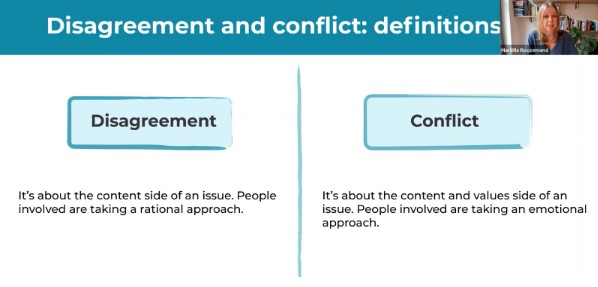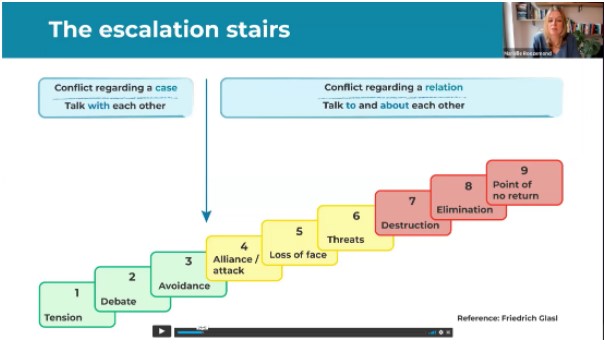This blog is based on the talk ‘Confidently Navigating Disagreement and Conflict’ by Marielle Roozemond at the 2021 Agile Business Conference. We’ve placed Marielle as the narrator, so you can read it in her voice. Members can also hear her voice by watching the full talk. Watch Marielle Roozemund at the Agile Business Conference | Agile Business Consortium
“Agile teams really open up to each other. They share knowledge, they can deep dive into certain content issues, and explore things a lot. But I also notice a tendency to shy away from more difficult interactions, like disagreements and conflicts.”
Difference between disagreement and conflict

Marielle discusses the difference between disagreements and conflict and says both are about the subject, facts and context of the disagreement, which she describes as the content of an issue. She says, “When we talk about disagreement, we talk about the content side of an issue. People take a rational approach, but emotions can still come into play.
“Then when we go through the conflict side, you see it's still about the contents, but values come into play, and emotions follow in the slipstream. It gets more personal. You can imagine the values you live by them, and you're ready to defend them.
“You go from disagreement to a conflict. It all gets more personal, which is why conflicts tend to escalate quite easily.”
The escalation stairs
“Friedrich Glasl depicted it, and it's a very handy tool if you want to know where you are in conflict or disagreement. Most disagreements or conflict starts in the Green Zone... and then when the conflict isn't resolved in some way, it goes up the stairs and could enter the red zone.
“So, it's a very useful tool to analyse where you are in a conflict. You can ask yourself the question:
Do I have a conflict or does the conflict have me?

“Here you can also analyse what kind of intervention is useful.
- In the green zone, people will work it out together. There is a willingness to understand each other and to work it out.
- In the yellow/amber zone, you need someone who can mediate. You can ask a colleague, manager, or someone with great listening and empathy skills. And good empathy. And from there, you can divide the time between the parties involved, let them explain their viewpoints and work to try and de-escalate to get into the Green Zone together.
- In the red zone, you need a higher overarching manager or higher up to decide a way forward and be bold with it.”
Tools
“Your brain wants to protect you when you feel threatened.
“So I open up. Share my reality and then they can share their reality back. This immediately eases the breakdown and we really listen to each other. Asking some more questions, we switch on our empathy buttons again. And that is really helpful and it sets in motion a new way of collaborating with each other, and it's even easier to feel more trust. Building an Agile Culture through Trust - Agile Business Consortium
“But it’s not always easy to open up because your brain wants to protect you. So how do you get over this threshold? Well, you can always use some tools:
Keywords
“When you are in a conversation and you notice tension is building up, you can just listen carefully for keywords. Then you just go around the room and ask everyone to write down the definitions of the keywords. Then ask the participants if there are some kind of shared definitions emerging. The reason why you do it, is that you first ask everyone for the definition, and this helps everyone open up. Then you direct the energy back to invite them back to the ‘higher brain’ levels so they can find a shared meaning.
Exploration
- What is true?
- What is meaningful?
- What is useful?
“You first ask everyone ‘what do we know?’ about this topic of disagreement. You'll gather all facts and figures, go around the room, and write it all down. And then you ask, ‘what is meaningful?’. And every participant opens up and shares what is meaningful for them in relation to the topic. Then ask what is useful now and useful in the future. Then you look to see if there is a solution emerging or a way to go forward.
“So, it's the same as you do with the keyword exercise. You ask everyone to open up, invite everyone to go to the higher brain levels by opening up to each other perspectives, and actively switch on the empathy part.”
Recognise and side track the signals from your amygdala
The amygdala is deep in the brain, and it helps regulate emotion and encode memories. It is part of the limbic system and plays a key role in how we respond to environmental threats and challenges and prompts an appropriate response.
Marielle says, “When your brain is trying to protect you, it can activate your fight or flight system. Some ways to help you fight it:
- Recognise when you start making internal movies about personal motives and about the situation. Try to stop doing that immediately because you know one thing for sure, it's very unique for you and the other person won't recognise it at all. That internal movie is made out of your own unique, highly personal memories and emotions
- You can always step out of the situation. Just get a glass of water or something
- You can always escape your amygdala by looking into the wider surrounding. Just look out the window and pick something 20 metres away from you. Start focusing on the shapes, the colours, the texture, et cetera. And when those details consciously enter your mind, you're ready to turn your gaze back into the room”
Summary
“Conflict awareness is essential if you want to build high functioning teams. If you don't take your whole self to the workplace, then you don't engage in debates about the content. That will result in a lack of commitments in the agreements you make with your team. And a lack of commitment will result in avoidance of accountability for certain tasks and responsibilities. And that leads to inattention to results. So it's really essential that we learn to use conflict coping skills and disagreement coping skills.
We’d like to thank Marielle Roozemond for her contribution to our 2021 Agile Business Conference.
Please note blogs reflect the opinions of their authors and do not necessarily reflect the recommendations or guidance of the Agile Business Consortium.
